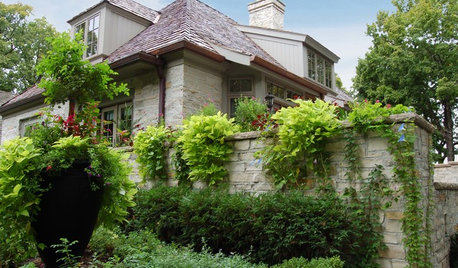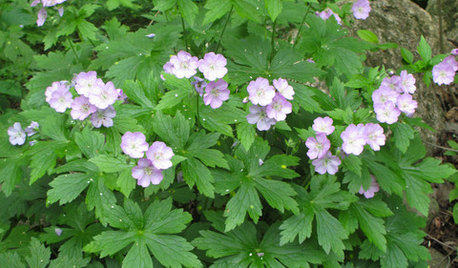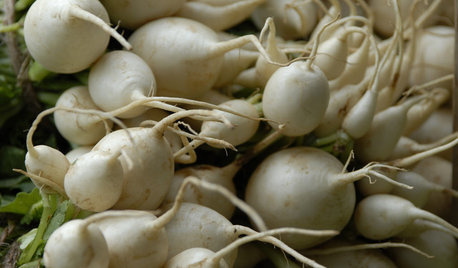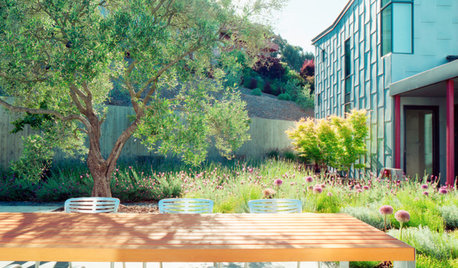Potato Varieties For Oklahoma
On another thread, Carol mentioned potato varieties and I thought I'd start them a thread all their own so it will be easy to find later on using the GW search funtion.
Carol,
For full-sized potatoes in Oklahoma, you can't go wrong with Red Soda, Red Pontiac, Red Noland, Kennebec, Norgold, Yukon Gold or Norkota. The local stores here usually have only one russett variety and it generally is labeled only as "Russett" so I don't know its specific variety name but it grows and produce alright as long as I plant it on time. I believe all of those, and probably some that I've forgotten, are on the list of OSU-recommended varieties.
If you like potatoes in less-well-known colors, Ronninger's and Wood Prairie Farm both have a great selection. We've grown and liked quite a few blue or purple potatoes, including All-Blue, Blue Adirondack, Purple Viking, Peruvian Purple and Purple Majesty. For Red, there's All-Red, Adirondack Red and several others. This year we grew Mountain Rose and it grew pretty well.
If you like fingerlings, French Fingerling and Austrian Crescent have performed well for us. Red Thumb produced, but not very well. We've also grown Russian Banana, and Rose Finn Apple fingerlings and they produced OK but not high yields.
This year I grew a lot of varieties that were new to us and some produced well and others didn't. However, I misplaced my map that told me which row had which kinds in it before I got around to digging them, so can't really say which ones performed well and which didn't because I'd just be guessing at the specific varieties. I do know that Purple Viking and Adirondack Blue produced very well in a container though.
Dawn
Comments (21)
soonergrandmom
13 years agolast modified: 9 years agoThanks Dawn. I grew Kennebec and Yukon Gold this year, and although they produced about the same amount the Yukon was earlier and we thought it was a much better potato. In the spring, Atwoods had about 7 or 8 kinds, but since I don't normally plant potatoes, I just guessed at what to buy and only planted a few. I actually got much better production than I expected. Thanks for the ideas. I know they had the more common ones, and it seems like I remember a blue as well. Yukon Gold makes the best potato salad that I have ever eaten. Yum.
Thanks for the names, and the new thread so I will be able to find it next spring. Carol
carsons_mimi
13 years agolast modified: 9 years agoWell, unless Carol starts mentoring (I remember those pans full of potatoes) or Dawn writes a "Growing Potatoes for Dummies" book, this will be my first and last year to attempt potatoes. I don't know what went wrong but it was sad, sad, sad....
Related Professionals
Simpsonville Landscape Architects & Landscape Designers · Ballwin Landscape Architects & Landscape Designers · Saint Charles Landscape Architects & Landscape Designers · Sand Springs Landscape Architects & Landscape Designers · Woodinville Landscape Architects & Landscape Designers · Paradise Landscape Architects & Landscape Designers · Frisco Landscape Contractors · East Hanover Landscape Contractors · Gloucester Landscape Contractors · Las Vegas Landscape Contractors · Arbutus Decks, Patios & Outdoor Enclosures · Greeley Decks, Patios & Outdoor Enclosures · Green Bay Decks, Patios & Outdoor Enclosures · North Aurora Decks, Patios & Outdoor Enclosures · Olathe Decks, Patios & Outdoor EnclosuresOkiedawn OK Zone 7
Original Author13 years agolast modified: 9 years agoCarol,
You're welcome.
I am perpetually freaking out my family with vegetables that are the "wrong" color.
The first time I made mashed potatoes from All-Blue potatoes, I had to answer questions about our lovely lilac-colored mashed potatoes. I thought they were quite beautiful, but had to explain "no, I did not put food coloring in the potatoes", etc. Never a dull moment here.
Carson's Mimi, Do you have clay soil? Potatoes really need friable, fluffy soil with lots of organic matter in order to reach a nice size and produce a good yield. They also need to be planted about a month before your last average frost date but planting them "on time" does leave them vulnerable to freeze damage from a 'late' freeze.
I get the best yields when I plant on time, when spring weather is moderately wet but neither excessively dry or wet, and when we have a long, cool spring. The early onset of very hot weather seems to reduce yields.
You do have to plant them deep. I plant in the bottom of a trench and slowly fill it in as foliage emerges. I aim for a trench 8-10" down, although 8" is probably perfectly adequate. Once the trench is filled in and level with the ground around it, you can either hill up around the plants with dirt or mulch heavily. This year I mulched very heavily with fresh alfalfa hay and liked the results and it was so much easier than hilling up.
Choosing varieties recommended for Oklahoma helps, and I like early- and mid-season types more than late-season types because they produce higher yields most of the time.
To me (and Gary can correct me if his results are different because he's a real farmer and I'm just a gardener), it seems I get the best yields when spring is long and cool and moist but not soggy. I'm not a potato expert though and, believe me, I have plenty of frustrating years when the yields are maddeningly low.
No matter how much I dig, I always miss a few small potatoes and they tend to grow the following year. When I dig in June or July, I replant the small potatoes in the same area (to go along with whatever ones I missed) and as long as July/August aren't terribly wet, the potatoes sprout and grow and I havest them in very late fall. I've also thrown potatoes on the compost pile after they sprouted in the tornado shelter and have had them produce a great crop in the compost pile.
If your space is limited, you could try potatoes in containers. Some folks have had really great results with Smart Pots but I have had luck with regular old 5-gallon buckets with drainage holes drilled in the bottom.
Why grow potatoes why they're relatively cheap at the grocery store? Because fresh, home-grown potatoes have a rich, earthy flavor you don't get from store-bought potatoes that may have been in cold storage for many months before we buy them. The first time my DH tasted fresh, home-grown potatoes from the garden, he said "They taste like dirt, and I mean that in a good way." His words made me laugh out loud, but I understood what he meant, and that is the flavor I describe as 'earthy'.
I wouldn't judge ANYTHING based on the 2010 growing season. Do we need a recap? Snow and ice in January. Cold and ice in February. Cold and snow in March. Rain, hail, wind, tornadoes, floods and some very cold nights in April. Rain, hail, wind, tornadoes, some flooding, and then some very hot days and high heat indices in May. How about June? Hot, hot, hot, humid, humid, humid, high heat indices, some rain, some flash flooding, massive invasions of bugs, including Colorado Potato beetles. Some folks had hail. July? A repeat of June but with less to no rain in most of the state. August? Hot, dry, some rain in some places while in others the drought continued, but mostly miserable weather all over. September? The drought drags on, but some areas got tropical moisture and flooding rains (and some folks had tornadoes) from the remains of tropical cyclone Hermine. Etc. Etc. Etc. If you were a potato, tomato, corn, bean or pumpkin, would you want to grow in the weather 2010 threw at Oklahoma? I wouldn't!
That leads us back to our favorite Oklahoma gardening slogan....."There's always next year."
Try potatoes next year and we'll hold your hand and walk you through it!
Dawn
soonergrandmom
13 years agolast modified: 9 years agoI bow to the experts on this one, since that was probably only the third or fourth time I had grown them in my life. The only thing I didn't like about them was that they were dry and dead looking and falling over when the rest of the garden looked picture perfect. LOL I used both dirt and straw because someone told me they would grow all along the stem. Well, I don't know what they planted but that was not the case with mine. Since my plants were HUGE, I would have had quiet a crop if that had been true. I probably dug mine a couple of weeks too early, but they were falling over onto other plants. That's why I want to find a place outside my main garden for next year. I didn't have an insect problem with mine at all, but I have had potato beetles in the past.
Okiedawn OK Zone 7
Original Author13 years agolast modified: 9 years agoCarol,
The size of the crop you raised this year makes you an instant expert.
I think the latest research I've read (and it wasn't all that recent either) shows that most potato plants will produce tubers along about 8" of below ground stolon or stem or whatever they call it. So, there's really no reason to go deeper than 8 or 9" at planting time, and the only reason I hill up dirt or use straw is to keep any potatoes that partially pop up out of the surface of the ground from turning green from direct sunlight. If you don't plant deep and plant your seed potatoes say 2 to 4" below grade level, then hilling up or heavy mulching is much more important because it gives the plant stolon 8" or buried stem along which to form tubers.
I have moved my potato-growing area out of the main garden because they do look so very sad as their plant tops are dying down. I know it is not imperative to have a 'pretty' garden and preferable to have a productive one, but I still like for my garden to look as nice as possible. Next year, I may move the potato area even further away....completely out of sight behind the garage. After this year's huge invasion of potato beetles, I need to rotate next year's crop to an area as far away from this year's potato area as I can.
I am thinking of growing all my tomatoes in those big rope-handled muck buckets next year. It sure would make it easier to 'dig' them, wouldn't it? I could tip over the buckets onto a tarp or sheet of plastic, rake out the soil and potatoes, gather the potatoes and then rake the soil back into the bucket. Then, I could plant a succession crop in the bucket.
Dawn
slowpoke_gardener
13 years agolast modified: 9 years agoI saw the rope handle muck buckets at walmart yesterday for $5.00 ea., thought that was a fair price, bur I already need another shed to stack my junk in.
Larry
kellygirrl
13 years agolast modified: 9 years ago"...most potato plants will produce tubers along about 8" of below ground stolon or stem or whatever they call it. So, there's really no reason to go deeper than 8 or 9" at planting time, and the only reason I hill up dirt or use straw is to keep any potatoes that partially pop up out of the surface of the ground from turning green from direct sunlight."
If you don't mind someone from Iowa butting in. :-)
I've discussed this with an experienced grower on another forum. He explains that to grow more potatoes, the stolon is covered every few days with soil, when the stem is just 2-4 inches high with just 2-4 leaves. This prevents sunlight from forming chlorophyl in the stolon, thereby turning it into a stem. Potatoes will not grow up a buried stem. They will grow up a stolon for possibly 2 feet, over a period of 6 weeks. You must use long season potatoes, or it will not work. If you are late in covering the plants, you are burying stems rather than stolons, and you will not get the extra potatoes, and that is apparently why a lot of people think it doesn't work.seedmama
13 years agolast modified: 9 years agoI'm phone shopping for seed potatoes and decided to bump this. K&K has Red Pontiac, Red LaSoda, Kennebec and Yukon Gold, with plans to add other varieties.
Dawn,
You mentioned you might be growing potatoes in containers. Do you use potting mix or dirt?Okiedawn OK Zone 7
Original Author13 years agolast modified: 9 years agoI use potting mix. All my dirt is clay, except for the narrow sandy band where the pecan tree grows and the fire ants live.
I'd never put normal dirt into a container because it packs down so hard over a period of time when watered, which might not be as much of an issue with potatoes as it is with most plants.
I think if you grew potatoes in a open-bottomed container like old tires or potato boxes (wooden boxes that have sides but no bottom), you could use dirt....or at least you could use YOUR dirt because you have good sandy loam, right? I have the kind of clay you make red clay pots from, so it wouldn't work for me.
I bought Red LaSoda today to go with the other ones I have, which are Purple Peruvian, Red Pontiac, Kennebec, and Yukon Gold.
My catalog from Ronninger's arrived today but I haven't looked at it because I am afraid it will give me potato planting fever.
Dawn
gardenrod
13 years agolast modified: 9 years agoAtwoods in Broken Arrow has seed potatoes for $ .69 per pound if anyone is interested.
RonOkiedawn OK Zone 7
Original Author13 years agolast modified: 9 years agoCarol,
You know, the more you learn about gardening, the harder it is to answer a simple question about spacing (or any other question), but I'll try. Because of all the different types of soil and different ways to plant, I'll likely give you 5 or 6 answers to your question instead of one.
I suppose the proper answer would be to say that we all should follow the OSU recommended spacing for potatoes which say to plant your seed potatoes 1' apart in rows 3' apart. That's not how I do it most of the time though. Instead, I tailor my plant spacing to the particular area where I'm planting, taking into consideration the friability of the soil, its fertility, its drainage and its water-holding capacity, and whether I'm planting in grade-level soil, raised beds or containers. I also space seed potatoes much farther apart in a drought year to try to prevent excessive drought stress.
If I am planting potatoes in a raised bed with somewhat fluffy, loamy clay thats been highly improved through the addition of lots of organic matter over the years, I generally use spacing similar to what John Jeavons recommends, generally planting the potatoes on 9" centers, spaced 9" from one another in all directions. Wherever I have a "hole" or "gap" along the edge of the raised bed which includes space in the 9" between two seed potatoes, I stick a petunia or a sweet alyssum plant into that gap to pretty up the bed and attract beneficial insects. Having the flowers there might reduce the potato yield a little but I don't care. I always mix flowers and herbs into my beds because I like a pretty crazy quilt garden and not one that looks like a perfectly-spaced agricultural field of straight rows.
If I am growing in a wider than average raised bed (I have two that are wider than the others) and I want to plant in straight rows, which suits those two beds since they are so wide, then I plant them 8 to 12" apart in two rows that are 20" apart. My other raised beds are not as wide and I could put only one row doen the middle of those beds, so I use the 9" center spacing in them.
If I am planting into a grade-level garden plot that doesn't have raised beds, then it likely is in the sandy soil on the south side of the pecan tree where the soil is slightly improved sand. No matter how much organic matter I add to the soil here in this area, it pretty much all decomposes by the next year, so I never make a lot of headway in really improving it a great deal...it's that old "heat eats compost" rule in play. In this area I use more traditional (but not entirely) spacing of 8 to 12" between seed potatoes in the rows and 2 to 3 feet between rows. While 2 to 3' sounds like pretty wide spacing, you know how tall and wide potato plants get...so they all grow together into one big mess with no real pathways between them, but I do start out with proper spacing even if it doesn't look like it by May or June. If I am planting fingerlings in that area, I go with 2' spacing between rows but use the 3' spacing for regular potatoes.
If I am planting in grade level clay soil like I have in the lower section of my garden and it is fairly well improved but not a raised bed and so more prone to drainage issues, I plant the seed potatoes 12" apart in rows 3' apart and just hope for the best. If it is a rainy year, this area may stay too wet and I may lose the potatoes, so I tend to use it for potatoes only in a dry year.
If I am planting in containers, I just try to adjust the planting as best I can and what I do will vary depending on the size and shape of the container but I mostly space the seed potatoes 6 to 8 inches apart in the container.
If I am planting in a cage using the mulch method, I'll plant the seed potatoes about 6-8" apart and will put about 4" of a soil/compost (but not manure, and in fact never fresh manure in the current year because of scab) blend on top of them. As they grow upward, I keep adding alternating layers of grass clippings/straw and compost until the plants either top out at their usual height or until they flower. I generally leave about 5 or 6" of the plant's top growth unmulched and exposed at all times.
It takes some tinkering to figure out what works best in your soil and your growing conditions. Unless you live in an area with good rainfall, you'll get a bigger yield with rows spaced 2' or 3' apart. If you're in a heavy rainfall area, you can get away with spacing your rows 18-20" apart.
Hope this helps,
Dawn
soonergrandmom
13 years agolast modified: 9 years agoActually I probably had mine about a foot apart on all sides in a wide garden bed and they did just fine, but I was thinking that I might try a cage type system and was wondering if I could go to a closer spacing. Mine were very healthy looking, I didn't have an insect problem at all, unless you count the ants at digging time. The plants were so close that they touched each other but they grew to about waist high. I dug a little earlier than I should have because I couldn't stand the ugly things after they started to die and fall over, but I still got a decent crop. I had hoped to plant them in another location out of the garden this year, but I didn't get it ready. I hate to miss not having them since they were wonderful last year so I guess I'll just have to put up with the ugly.
Okiedawn OK Zone 7
Original Author13 years agolast modified: 9 years agoThe ugly is just one of those things you have to endure with potatoes. Sadly, the best place for me to plant them is in a spot where everyone who comes to the house has to drive right by them. I always feel like I should put up a sign at that time of year that says something like "Yes, they are supposed to look like this" or something. What I really need to do is rototill and enrich soil and make a new potato garden somewhere out of sight where no one can see it at all.
seedmama
12 years agolast modified: 9 years agoCarol, would you consider spacing your potatoes 1 foot in every direction again?
Anybody else? I grow in 48" wide beds. If I plant one row 12" in from the edge, the next row straight down the middle, and the third row 12" from the other edge, I can plant 50% more than if I plant two rows 30" apart. The question is, would I be better off for total production by including the middle row, or by allowing the two outer rows to claim that space?
My soil is newly tilled with LOTS of compost, and the two rows of drip irrigation are spaced 18" in from the edges.
soonergrandmom
12 years agolast modified: 9 years agoSeedmama - I would plant 3 rows, but you know what my opinion is worth. LOL
soonergrandmom
12 years agolast modified: 9 years agoI liked mine in a bed with close spacing and I got a lot of potatoes, but it was a hassle to get mulch in between the plants and I was afraid the potatoes would receive light so I kept stuffing straw in between the plants.
I planted in the ground this year and in rows so I could compare. The potatoes are about 9-10 inches apart, but the rows are about 2 feet apart (not that I measured).
We have had very little rain this year, only about 2 1/4 inches, but when I pulled the leaves back, the soil was perfect for planting. We planted the potatoes at about 6 inches and pulled some leaves and soil back over them and will add the additional soil back over them as they grow. I planted Yukon Gold and a red one that I don't know the name of. Al called me from a different store the other day and asked me if I wanted more. I told him if they had Kennebec about the size of golf balls, with eyes, to bring me a few, but I didn't have much room. He found about 8 potatoes that met the size so I still have those to put in the ground somewhere.
All of the potatoes had names on them except for the red ones that looked like the best seed potatoes to me, so I just bought them without knowing what kind they were. I am so exacting with my garden. LOL
elkwc
12 years agolast modified: 9 years agoYou all are way ahead of me. I'm chitting mine now. I will plant mainly a Tom Wagner variety named Azul Toro. It is a deep blue/purple potato. Was the only variety that survived and the hail and produced any numbers last summer. I should have several extra of it too share. Although the tubers will be small. Most of those the plants produced after the beating by the hail was small. Has a very unique texture and great flavor. I have some variety from the store that is developing nice chits so may drop a few in the ground soon for early potatoes. Also have a couple of Yukon Gem that I saved from last season. Had one plant that survived the hail and produced 4 small tubers. Two didn't store well so will plant the other 2. I usually space mine 10-12 inches apart in a single row. I have 70 ft rows in the main garden and I don't grow that many spuds. So never worry about spacing a second one. Jay
soonergrandmom
12 years agolast modified: 9 years agoJay, If my rows were 70 feet, I wouldn't worry about a 2nd one either. My whole garden isn't 70 feet. I don't know how big my garden is, except that it isn't big enough. (grin) Our lots are narrow in the back and get wider toward the street.
Even if I knew the size, it doesn't tell the story because I have structure shade, a tree, and various other things to work around. I have spent a lot of time moving things around as I have improved the soil and made the garden larger.
I think I now have it more or less permanent and I grow vertical as much as possible. I have a cattle panel arch over the walkway that gives me a good tall trellis. I have a cattle panel cut in half and both pieces mounted side by side vertical which also serves to shade the air conditioner unit a little and gives me an 8 foot trellis. I have 3 cattle panels that each give me 16 feet of trellis for peas and beans. I have one more thing that was once one of those little windmill yard ornaments that is now just the tower and I grew cukes on it last year. Then I probably have about 20 feet of chain link fence that I can put a few things on. The entire space has chain link on 3 sides, but part of it would shade a neighbors garden if I planted a vine, some has grapevine, some is shaded. Of course I also have my CRW cages for tomatoes. When I fill all of that I move outside the fence where I have a sunny area where I can use containers. Where there's a will, there's a way.
















Okiedawn OK Zone 7Original Author